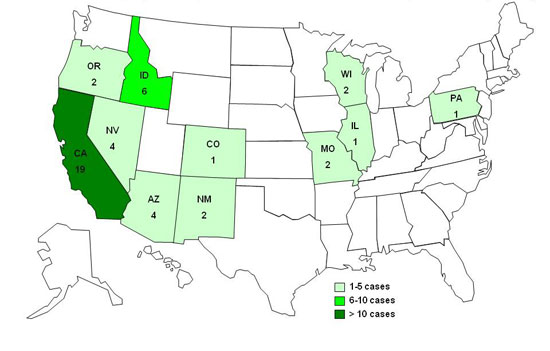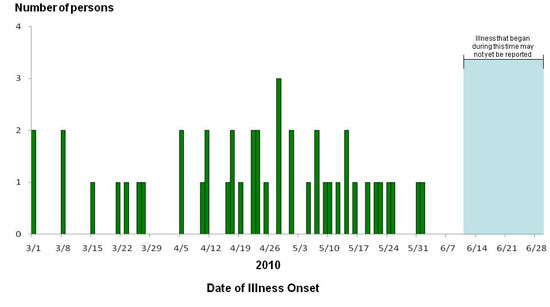2010 Salmonella Outbreak Linked to Raw Alfalfa Sprouts
NOTICE: This outbreak is over. The information on this page has been archived for historical purposes only and will not be updated.
Posted June 29, 2010
Outbreak Summary
CDC has been collaborating with public health officials in many states and the U.S. Food and Drug Administration (FDA) to investigate a multistate outbreak of Salmonella serotype Newport infections linked to the consumption of raw alfalfa sprouts. Investigators used DNA analysis of Salmonella bacteria obtained through diagnostic testing to identify cases of illness that may be part of this outbreak.
As of 11:00 PM EDT on June 24, 2010, a total of 44 individuals infected with a matching strain of Salmonella Newport have been reported from 11 states since March 1, 2010. The number of ill people identified in each state with this strain is as follows: AZ (4), CA (19), CO (1), ID (6), IL (1), MO (2), NM (2), NV (4), OR (2), PA (1), and WI (2). Among those for whom information is available about when symptoms started, illnesses began between March 1, 2010 and June 1, 2010. Case-patients range in age from 1 to 85 years old, and the median age is 38 years. Sixty-eight percent of patients are female. Among the 34 patients with available hospitalization information, 7 (19%) were hospitalized. No deaths have been reported.
The outbreak can be visually described with a chart showing the number of people who became ill each day. This chart is called an epidemic curve or epi curve. Illnesses that occurred after June 11, 2010, might not yet be reported due to the time it takes between when a person becomes ill and when the illness is reported. This takes an average of 2 to 3 weeks. For more details, please see the Timeline for Reporting Cases of Salmonella Infection.
Outbreak Investigation
Collaborative investigative efforts of many local, state, and federal public health, agriculture, and regulatory agencies have linked this outbreak to eating raw alfalfa sprouts. Interviews of case-patients found that most reported eating raw alfalfa sprouts before becoming ill. Some case-patients reported eating sprouts at restaurants; others purchased sprouts at grocery stores. The initial investigation traced the implicated raw alfalfa sprouts to a single sprout processor in California. Investigations were conducted at the sprout processor.
Recall Information
On May 21, 2010, J.H. Caldwell and Sons Inc. of Maywood, CA, voluntarily recalled several brands of alfalfa sprouts distributed to wholesale distributors, restaurants, delicatessens, and grocery stores.
Clinical Features/Signs and Symptoms
Most people infected with Salmonella develop diarrhea, fever, and abdominal cramps 12–72 hours after infection. Infection is usually diagnosed by culture of a stool sample. The illness usually lasts 4 to 7 days. Although most people recover without treatment, severe infections can occur. Infants, elderly people, and those with weakened immune systems are more likely than others to develop severe illness. When severe infection occurs, Salmonella may spread from the intestines to the bloodstream and then to other body sites and can cause death unless the person is treated promptly with antibiotics.
More general information about Salmonella can be found here under Salmonella FAQs.
Advice to Consumers
- Recalled products might still be in grocery stores, restaurants, and consumers’ homes. Recalled products should not be consumed. Consumers are advised to review FDA’s recall site for a list of recalled products.
- Individuals who think they might have become ill from eating a recalled product should consult their health care providers.
- Children, the elderly, pregnant women, and persons with weakened immune systems should avoid eating raw sprouts of any kind (including alfalfa, clover, radish, and mung bean sprouts).
- Cook sprouts thoroughly to reduce the risk of illness. Cooking kills the harmful bacteria.
- Request that raw sprouts not be added to your food. If you purchase a sandwich or salad at a restaurant or delicatessen, check to make sure that raw sprouts have not been added.
General Information
CDC’s Role in Food Safety
As an agency within the U.S. Department of Health and Human Services (HHS), CDC leads federal efforts to gather data on foodborne illnesses, investigate foodborne illnesses and outbreaks, and monitor the effectiveness of prevention and control efforts. CDC is not a food safety regulatory agency but works closely with the food safety regulatory agencies, in particular with HHS’s U.S. Food and Drug Administration (FDA) and the Food Safety and Inspection Service within the United States Department of Agriculture (USDA). CDC also plays a key role in building state and local health department epidemiology, laboratory, and environmental health capacity to support foodborne disease surveillance and outbreak response. Notably, CDC data can be used to help document the effectiveness of regulatory interventions.
Final Case Count Map
Persons infected with the outbreak strain of Salmonella Newport, by state, as of June 24, 2010 (n=44)

As of June 24, 2010, a total of 44 individuals infected with a matching strain of Salmonella Newport have been reported from 11 states since March 1, 2010. The number of ill people identified in each state with this strain is as follows: AZ (4), CA (19), CO (1), ID (6), IL (1), MO (2), NM (2), NV (4), OR (2), PA (1), and WI (2).
Final Epi Curve
This outbreak can be visually described with a chart showing the number of persons who became ill each day. This chart is called an epi curve. Please see the Timeline for Reporting Cases of Salmonella Infection for more details on the reporting process.
Persons infected with the outbreak strain of Salmonella Newport, by date of illness onset*

*n=44 for whom information was reported as of June 24, 2010. Some illness onset dates have been estimated from other reported information.